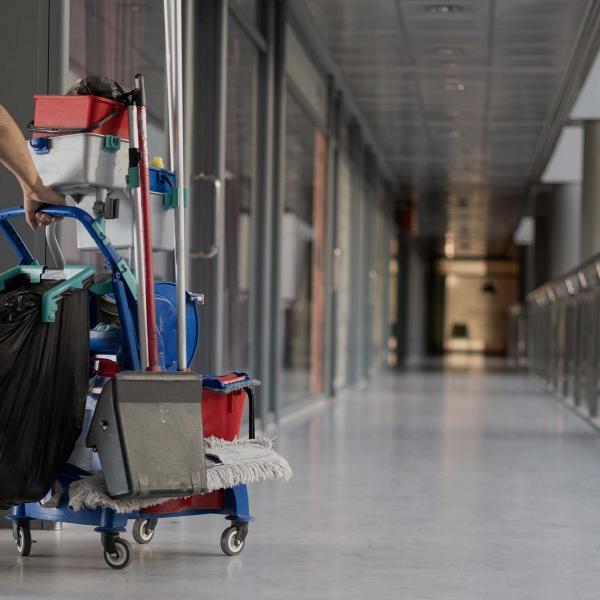Millions of people in England have missed out on hospital care during the course of the pandemic. That is partly because the NHS cancelled or delayed large volumes of non-urgent procedures in order to prioritise the treatment of patients with COVID-19. But it is also, at least in part, because people chose to stay away – perhaps because of a fear of catching the virus in a hospital environment, or a desire not to burden the NHS. In total, some 7.6 million fewer people joined a waiting list for NHS care in England between March 2020 and September 2021 than we would have expected based on pre-pandemic data. This suggests that there are millions of ‘missing’ patients: people who, in the absence of a pandemic, would have sought and received NHS hospital care but, in the event, did not.
The question we pose here is: where are these missing patients? It is true that the waiting list for NHS care in England has grown: there are currently 5.8 million people waiting for treatment in England, 1.4 million more than in February 2020. But while that is a large increase – more than 30% in less than two years – it is actually rather modest when compared with the number of people who have missed out on care. So, while some of those who stayed away during the early stages of the pandemic have since joined (and may still be on) the waiting list, many more have not (yet) formally joined. In other words, they are still missing.
This is a puzzle, and a hugely important one. For one, whether and when these patients do come forward to seek NHS care will have a massive impact on the length of future NHS waiting lists. The Health and Social Care Secretary, Sajid Javid, warned back in July that waiting lists could reach 13 million in England; subsequent IFS research showed that this was plausible, but only if NHS capacity remained constrained and these missing patients returned in large numbers. So far, there is little sign of the missing patients rushing back. That might be good news for the headline figures, but if people do not get the care they need – and subsequently need more extensive treatment because their health has deteriorated – this could just store up health problems for the future. Indeed, there is increasing concern about the patients who are still missing care, and Sajid Javid has repeatedly urged patients who missed care to come forward, as have NHS leaders.
In this observation, we examine the available data for signs of where these missing patients might be found. We argue that there is currently no evidence that they are returning to the waiting list for hospital care, and instead turn to two other potential explanations: that patients themselves are not returning to seek NHS care; and that patients are seeking care but are not being referred to waiting lists.
Missing patients are not (yet) joining the NHS waiting list
Figure 1 shows the number of people who joined the NHS waiting list in England in each month between January 2019 and September 2021. In almost every month since the onset of the pandemic, there have been fewer people joining the waiting list than in the same month in 2019. Overall, we estimate that there were 7.6 million fewer new joiners between March 2020 and September 2021 than we would have expected if the number of joiners were the same as in 2019. These are the ‘missing’ patients, and we would likely expect many of them to still need the care they missed out on.
However, if patients who missed care were now returning and being put on the waiting list, we would expect the number of new waiting list pathways (i.e. the number joining the list) to be substantially above 2019 levels. This is because the returning ‘missing’ patients would be on top of the ‘business-as-usual’ patients who develop a care need and join the waiting list for hospital treatment in any given month. But Figure 1 clearly shows that the numbers joining the waiting list are at, or below, 2019 levels. Indeed, even during the summers of 2020 and 2021, when there were relatively few Covid-19 patients in hospital, new joiners to the waiting list remained below 2019 levels.
Figure 2 presents more evidence that patients who missed care are not yet appearing on the NHS waiting list. The horizontal axis shows for large clinical specialties the number of patients treated in the first year of the pandemic relative to 2019 levels. The vertical axis then shows the number of new joiners since then. If patients who missed care were returning, we would expect the types of treatment that experienced larger falls during the pandemic to now have higher numbers of patients joining the waiting list. But in fact we see the exact opposite pattern: on average, clinical specialties that lost more care during the pandemic also have lower numbers of new patients now joining waiting lists.
A clear example of this is Trauma and Orthopaedics, the clinical specialty that delivers routine hip and knee replacements. During the first year of the pandemic, the number of these operations fell by almost 50%. Despite this, the number of people joining the waiting list for this treatment was just 80% of its 2019 level between March and August 2021. In contrast, the number of new Dermatology pathways fell by less than a quarter during the first year of COVID-19, but is now above pre-pandemic levels. This pattern is difficult to reconcile with a simple story of ‘missing’ patients returning to join the waiting list for NHS care.
The question is, if the missing patients are not coming forward and being added to the waiting list, where are they?
Patients are not returning
One potential explanation for this pattern could be that the ‘missing’ patients are simply not seeking the NHS care that they missed during the pandemic. This could be for a number of reasons: it may be that the care is no longer needed, that those who need care have died, that patients are going private, or that patients are choosing to live with their condition rather than come forward for care.
It seems unlikely that these patterns are driven solely or largely by higher mortality from COVID-19. Approximately 125,000 people have died in England within 28 days of a positive COVID-19 test, and 140,000 have died with COVID-19 on their death certificate. It is true that someone can join the NHS waiting list multiple times with multiple ailments, and many of those who have died during the pandemic were older and sicker than the average person. But even if all of these individuals would have received several elective hospital treatments over the last 18 months, this is still an order of magnitude less than the 7.6 million fewer patients who have joined the waiting list during the pandemic. For COVID-19 deaths to explain the gap, each of the 140,000 who died would have had to join the waiting list more than 50 times in an 18-month period. COVID-related mortality is therefore, at best, only a partial explanation for the large number of ‘missing’ patients.
Another possible explanation is that long waiting times are driving more patients to seek private treatment instead of joining the NHS waiting list. Data from the Private Healthcare Information Network (PHIN) suggest a 30% increase between 2019 and 2021 in the number of people opting to self-fund private treatment, while a recent YouGov poll (commissioned by PHIN) showed that 22% of people say the COVID-19 pandemic has made them more likely to consider using private healthcare. While this and other evidence points to growing demand for private healthcare, the numbers at play are simply too small to explain away all of the ‘missing’ patients. According to PHIN data, 65,000 people opted to self-fund private treatment between April and June 2021, up from 50,000 during the same period in 2019. Over the same period, 370,000 fewer people joined the NHS waiting list than we would have expected based on pre-pandemic data. If only 15,000 (or less than 5%) of these people went private, then this too is at best a partial explanation.
Many of the ‘missing’ patients will not have died or gone private. Instead, their condition may have resolved itself without NHS attention, or they may simply have learned to live with it. It is difficult to assess how many people fall into this category because, by definition, they have not come forward for care and thus are not recorded in the aggregate figures. Some may still come forward eventually: NHS research, published in August, indicated that 60% of people were still concerned about burdening the health service, and 49% said they would delay seeking medical advice compared with before the pandemic. But it is impossible to know how many will eventually return, or when.
Primary care
We argued above that there are no signs of the missing patients joining the waiting list for hospital care. Hospitals, though, are just one part of the NHS, and it could be that patients are showing up somewhere else, but failing to make it onto the waiting list. The main way that patients join the waiting list is for their GP to refer them to a specialist hospital consultant for further investigation or treatment.
Figure 3 shows the number of GP appointments and referrals in 2020 and 2021 compared with 2019. Since March 2021, the number of GP appointments has been approximately equal to, or even slightly higher than, 2019 levels. Despite this, the number of GP referrals has remained consistently below 2019 levels. This suggests that the rate at which GPs refer patients for hospital care has fallen. If, over the period between March and September 2021 (during which the number of appointments returned roughly to ‘normal’), GPs had continued to refer patients at the same rate as they did in 2019, an additional 850,000 people would have been referred and (presumably) have joined the NHS waiting list. This suggests that changes to GP referral behaviour could explain a fair chunk – perhaps more than a tenth – of the 7–8 million missing patients.
If the number of GP appointments is above pre-pandemic levels, why is the number of GP referrals lagging behind? There are a few possible explanations. The pressure of treating COVID-19 patients and large waiting lists may mean that hospitals have raised the severity threshold for accepting referrals, or more directly discouraged GPs from sending patients. Moreover, if a GP thinks that the referral is unlikely to be accepted or it will take many months for the patient to be seen by a specialist, they may delay or refrain from making the referral in the first place. It is also possible that changes in GP referral behaviour are related to the far-reaching changes to how GP practices have operated through the pandemic (such as the shift towards telephone appointments), but evidence on this point is lacking. Notably, Figure 3 also shows that referrals from sources other than a GP (which include referrals from hospital consultants, from A&E departments and from other health professionals) have been above 2019 levels since March of this year. Whatever factors are reducing the number of GP referrals to the waiting list, they do not seem to be affecting these other routes.
What does this mean?
Where are the missing patients? At this point in time, we are left with the rather unsatisfactory conclusion that the evidence is inconclusive and that we will learn more in time. We can, however, draw some extremely tentative conclusions. There is some evidence that patients are showing up to see their GPs but that they are being referred for hospital treatment in smaller numbers than we would expect: roughly 850,000 extra people might have joined the waiting list since March if GPs had referred patients at the same rate as in 2019. Some patients will have died and some will have gone private. But even taken together, it is difficult to see how these explanations can account for anything close to the 7–8 million people ‘missing’ from the waiting list.
For as long as the missing patients fail to return en masse, NHS waiting lists are unlikely to rise to anything like the 13 million Sajid Javid warned about in the summer. But what ultimately matters is not how many people have officially joined the waiting list, but how many people are in need of treatment. If someone is not joining the list because they genuinely no longer need treatment and their health problems have been resolved, that is good news for the person and good for the NHS. If they have opted to go private, they will get the care they need and potentially relieve pressure on the NHS – but this is of course not an option available to all.
We ought to be most concerned about those who still need hospital care but have not received it. Failing to treat them risks storing up problems for the future. There are some signs of this already: the Royal College of Emergency Medicine and Matthew Taylor, CEO of the NHS Confederation, have both recently warned that patients are turning up in Accident & Emergency with more advanced and serious health issues as a result of delayed or missed treatment earlier in the pandemic. This is a problem that requires careful monitoring and, potentially, concerted policy efforts to find these patients earlier and encourage them to come forward.












